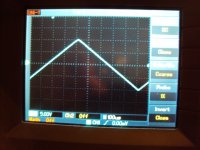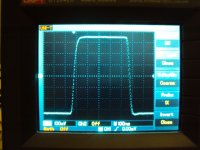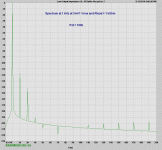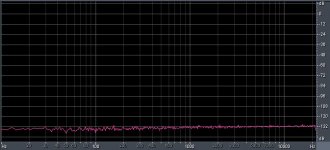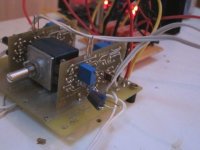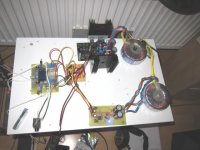He heard the oposite, that Linn and Rega where setting fast. I ones modified the original Roxan with an external quarz PSU and that was running quite fast. After modification it sounded very different. Roxan fixed that problem later. running too slow in the old english tables whould make the sound more fat and spectacular in the bass.
Maybe I have read that pulley tolerances in simple belt driven TTs produced some slowish TTs in that era. But I can't remember for sure, as I said.
Best than to use a motor controler. Pulley tolerance in unexpensive tables is typical. They are often not made from the same material as the turntable so thermo effects come in. In Jan Diddens table i simply fiited a string from NATO sewing wire.
PMAs answer prompted me to look more carefull into the performance of buffers. I will setup the next weeks a sonic comparison of various buffers i have posted here. The list is:
1: My version of the Salas B1 DC buffer. The major difference in my design is that i use
high grade double Fets with high Idss from Linear Systems.
2: My modified JLH buffer that i use in the JG-Self and in the FF2010
3: The IBuf with various Opamps, with and without class a to positive or negative
Supply. Opamps will be OPA134, OPA627 metal can, OPA1641, OPA827, OPA211
AD8065,
ADA4627, AD797, LT1115, LT1028, LT1468, NE5534A, LME49713, LME49710.
That covers up basically what i use at the moment here and there. If you want me
to include other, even exotic types tell me. This test will also include a comparison
of the Texas NE5534 against the original Signetics part so i try to get that red
hering from the table too.
4: My private reference open loop buffer. Measurements and simulation in the next
Post.
Conditions will be : PSU is one +-17V Hypnotize, FRD will be limitted with a 100 Ohm-22pf filter at the input on all buffers. I will use no potmeter before the buffers. Buffers will be put behind my best ULN Phonostage and drive a 5m long video caple to my Tube Monoblocks that have a 10kOhm pot at the input. We may try CD too. In this case it is a Horwege modified Pioneer universal player so i can also play DVD-A and SACD.
Buffer 1,2 and 4 could have a slight disadvantage beacuse they do not have a gain of exactly one. The plan is first to compare this buffers against each other, taken the best then and play it against the IBuf that will be reduced a bit in gain.
A major efford but it has to be done by someone. When the IBuf does well in comparison with the best of the discrete designs one other questions will be answered, if modern OPamp can compete with elaborated discrete solutions. It will also show how a discrete buffer with high feedback like the JLH fares against open loop buffers.
The listening panel will consist of Jürgen Hensler, Markus Schnier and me. Guests are invited if the schedule fits, two persons maximum at the time because i can sit only 3 persons including me optimally. I have various speakers around and also solid state amplification so if anybody has trouble with exotic dipols i have good alternatives.
Cables of most all major suplliers are in house too. I do not use cables with boxes though like the ones from Transparent, MIT etc. Standart 2 x 1.5qmm copper is availlable too for anybody that does not trust that cables make a difference or the ones that are affraid that cables with ecotic parameters disturb the experiment.
1: My version of the Salas B1 DC buffer. The major difference in my design is that i use
high grade double Fets with high Idss from Linear Systems.
2: My modified JLH buffer that i use in the JG-Self and in the FF2010
3: The IBuf with various Opamps, with and without class a to positive or negative
Supply. Opamps will be OPA134, OPA627 metal can, OPA1641, OPA827, OPA211
AD8065,
ADA4627, AD797, LT1115, LT1028, LT1468, NE5534A, LME49713, LME49710.
That covers up basically what i use at the moment here and there. If you want me
to include other, even exotic types tell me. This test will also include a comparison
of the Texas NE5534 against the original Signetics part so i try to get that red
hering from the table too.
4: My private reference open loop buffer. Measurements and simulation in the next
Post.
Conditions will be : PSU is one +-17V Hypnotize, FRD will be limitted with a 100 Ohm-22pf filter at the input on all buffers. I will use no potmeter before the buffers. Buffers will be put behind my best ULN Phonostage and drive a 5m long video caple to my Tube Monoblocks that have a 10kOhm pot at the input. We may try CD too. In this case it is a Horwege modified Pioneer universal player so i can also play DVD-A and SACD.
Buffer 1,2 and 4 could have a slight disadvantage beacuse they do not have a gain of exactly one. The plan is first to compare this buffers against each other, taken the best then and play it against the IBuf that will be reduced a bit in gain.
A major efford but it has to be done by someone. When the IBuf does well in comparison with the best of the discrete designs one other questions will be answered, if modern OPamp can compete with elaborated discrete solutions. It will also show how a discrete buffer with high feedback like the JLH fares against open loop buffers.
The listening panel will consist of Jürgen Hensler, Markus Schnier and me. Guests are invited if the schedule fits, two persons maximum at the time because i can sit only 3 persons including me optimally. I have various speakers around and also solid state amplification so if anybody has trouble with exotic dipols i have good alternatives.
Cables of most all major suplliers are in house too. I do not use cables with boxes though like the ones from Transparent, MIT etc. Standart 2 x 1.5qmm copper is availlable too for anybody that does not trust that cables make a difference or the ones that are affraid that cables with ecotic parameters disturb the experiment.
First is the clipping behaviour. The generator puts out 20V, my limmit. You can just see a small rounding of the triangle wave, similar in positive and negative direction.
Then a 1MHz squarewave, this time with a 150 Ohm, 33pF input filter.
Last the -3dB point at 7MHz with the 150 Ohm, 33pF filter.
Then a 1MHz squarewave, this time with a 150 Ohm, 33pF input filter.
Last the -3dB point at 7MHz with the 150 Ohm, 33pF filter.
Attachments
This is a simuation of distortion in reference buffer 4. That was an early prototype. It has been developed to perfection in the meantime but i have not made any real distortion measurements. Distortion is too low to be an audible problem anyway. Distortion on that low level may still add some "character" but it will not audibly sound distorted i any way.
Attachments
It´s hard to say where we put the frequency to define dynamic range.
That's not how it is done. For SNR and DR you have to integrate the noise over the bandwidth of interest, possibly after applying a weighting filter.
Further, the position of the noise traces on your graphs are a function of the FFT's bin size. The numbers you read there are thus meaningless.
CD doesn't have > 98dB dynamic range, but if you plot the noise of a 1-bit TPDF dither track in a 16 bit system, with a 65536 points FFT, the line is at -132dB below 0dBFS.
Attachments
Werner, i tryed to be polite and that is one of my biggest mistakes as a human being.
Enlighten us, we badly need a new norm and i already talked to the people at Braunschweig. DIN45500 shows it´s age but when i see 100.000,-€ horn speakers they do not even meet + - 10dB tolerance.
Enlighten us, we badly need a new norm and i already talked to the people at Braunschweig. DIN45500 shows it´s age but when i see 100.000,-€ horn speakers they do not even meet + - 10dB tolerance.
Werner, reading your post again, what kind of measurement setup whould you use to measure dynamic range ? I have a lot of equipment here and could apply weighting filters.
For N-bit digitizing, and M samples in the FFT record, one can get the noise bottom, apparent S/N, as low as:
S/N = 6.02N + 1.76dB + 10log(M/2)
So for 16 bits and 200 000 samples you may get 148 dB of apparent S/N. This is of course no real S/N, but something like spectral density at the bin size used, as Werner has already said.
S/N = 6.02N + 1.76dB + 10log(M/2)
So for 16 bits and 200 000 samples you may get 148 dB of apparent S/N. This is of course no real S/N, but something like spectral density at the bin size used, as Werner has already said.
I will consult with Jürgen Ultee. Maybe he has a good answer to the problem of measuring dynamic range on a vinyl record.
In case of the FFT analysis, you just have to take into account the FFT size. The same as if you calculate noise from Vn expressed in nV/rt(Hz). dF just replaced by bin size.
FF2010 Lineamp
Hello, to all those people who are interested in this thread.
As promised, I did a comparison of several PSU units, to feed the line stage designed by JG himself.
But first I have to report, that I have changed the 4,7K feedback resistor from metalfilm to naked Z-foil. Hey, again a step forward, much more sweet music came out of my speakers. This is a have to, if sb wants to rebuilt this wonderful linestage. More details, stage and a fantastic bass!
Ok, back to the PSU comparism.
These have been the candidats:
1. Salas PSU, with the suggested upgrades and 11R at the CCS
2. Kubato Regulater from China, a friend has built this.
3. Sulzer PSU
4. LC Audio PSU
5. Usual 3 leg PSU, but with LT337 und LT1086
My setup: Mod. Philips CD 820 with I/V Stage from Spencer
Hirage 8 Watt class A, Tantal and Vishay resistors, KimberKable
Speaker are Fostex FE207 in MLTL-Design from M.King, mod.
with Phaseplugs and Damping à la Planet 10
So I liked much:
1. Salas Hypno PSU, best bass and details.
2. LC Audio, maybe a little weaker bass, but voices are very sweet, I liked that very much. And my wife liked it best.😉
3. Sulzer PSU, not so fast, bass and details are a bit weak.
4. China Kubatu regulator, bass details and musical athmospere are missing.
5. Standart 3 leg PSU, sorry the other's can do everything better.
Remember this are my personal results!
What I have to say is, that the differences are marginal. Even with the standart 3-leg PSU it is a very,very, good sounding linestage!
I have compared it with my Kaneda linestage ( Tantal-R, Ladder Attenuator, Kaneda PSU), so I will say, if you compare the price for parts of the Kaneda and the FF2010, there is no choice for me, what I will do next.
Last thing I will do, is using 2 x12V lead batteries and the JG coils. And, maybe the SuperTeddyRegs.
Let's have a ear!
Thank you very much for sharing your design, Joachim.
And lots of thanks to Dietfried Braun who sent me four different PSU units.
Thank you very much.
Wkr
SAm
Hello, to all those people who are interested in this thread.
As promised, I did a comparison of several PSU units, to feed the line stage designed by JG himself.
But first I have to report, that I have changed the 4,7K feedback resistor from metalfilm to naked Z-foil. Hey, again a step forward, much more sweet music came out of my speakers. This is a have to, if sb wants to rebuilt this wonderful linestage. More details, stage and a fantastic bass!
Ok, back to the PSU comparism.
These have been the candidats:
1. Salas PSU, with the suggested upgrades and 11R at the CCS
2. Kubato Regulater from China, a friend has built this.
3. Sulzer PSU
4. LC Audio PSU
5. Usual 3 leg PSU, but with LT337 und LT1086
My setup: Mod. Philips CD 820 with I/V Stage from Spencer
Hirage 8 Watt class A, Tantal and Vishay resistors, KimberKable
Speaker are Fostex FE207 in MLTL-Design from M.King, mod.
with Phaseplugs and Damping à la Planet 10
So I liked much:
1. Salas Hypno PSU, best bass and details.
2. LC Audio, maybe a little weaker bass, but voices are very sweet, I liked that very much. And my wife liked it best.😉
3. Sulzer PSU, not so fast, bass and details are a bit weak.
4. China Kubatu regulator, bass details and musical athmospere are missing.
5. Standart 3 leg PSU, sorry the other's can do everything better.
Remember this are my personal results!
What I have to say is, that the differences are marginal. Even with the standart 3-leg PSU it is a very,very, good sounding linestage!
I have compared it with my Kaneda linestage ( Tantal-R, Ladder Attenuator, Kaneda PSU), so I will say, if you compare the price for parts of the Kaneda and the FF2010, there is no choice for me, what I will do next.
Last thing I will do, is using 2 x12V lead batteries and the JG coils. And, maybe the SuperTeddyRegs.
Let's have a ear!
Thank you very much for sharing your design, Joachim.
And lots of thanks to Dietfried Braun who sent me four different PSU units.
Thank you very much.
Wkr
SAm
Attachments
Thanks for listening. Your cables to the load are too long. Shorten and listen again if you may.
*Cut off the black board's excess if you aren't to implement the DCB1 part, it will come handy.
*Cut off the black board's excess if you aren't to implement the DCB1 part, it will come handy.
